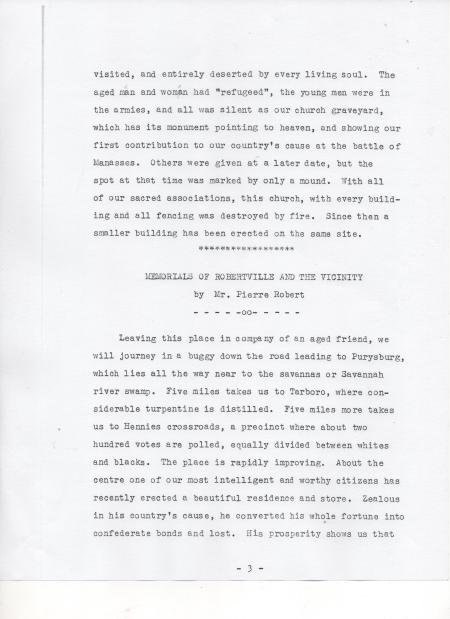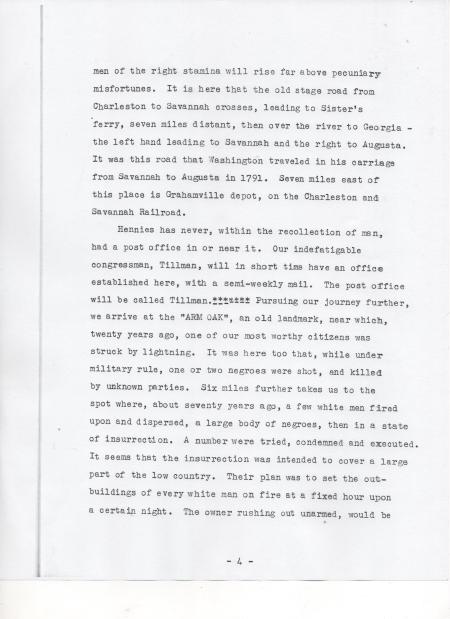(This is the 7th, and final, part of a series of papers compiled by Ora C. Paul, that are held in the Beaufort County Public Library, Beaufort District Collection.)
(Written for the Hampton Guardian of September the 12th, 1879)
******************
MEMORIALS OF ROBERTVILLE AND BLACK SWAMP, S.C.
dictated (by Jane Asenath Bostick nee Maner)
by Mr. Pierre Robert
for the Hampton Guardian of January 30th, 1880
– – – – – oo – – – – –
Following the road towards Augusta, upon the outskirts
of the village of Robertville, we come to Black Swamp, a
stream about one hundred and fifty yards wide and generally
two feet deep. It is crossed by a causeway. Upon this
edge of the swamp, for three miles up, there is a thick
growth of “ti-ti” bushes, excellent for pipe stems. Know-
ing ones scarcely pass without securing a supply. Singular
to say with the same kind of soil on both sides of the
swamp, there is not a “ti-ti” on the other. On the right
of the first bridge is the baptismal ground, or font, which
has been used for generations past as such. Within reach
stands a magnificent magnolia, its evergreen brances
always entwined with moss; in spring and summer, covered
with its splendid flowers, ten inches or more in diameter.
It is sixty-five feet high, and casts its shadow over the
waters. After leaving the swamp four hundred yards we
arrive at a large cluster of evergreen trees. It was here
that General Rutherford, with three hundred troops, was
– 8 –
stationed for a while during The Revolution, to be in
supporting distance of General Lincoln with his main
army of twelve hundred men, at Purysburg. Among the
latter was the heroic Sergeant Jasper and the chivalrous
gentleman and brilliant soldier, Col. John Laurens, who
was designated by Washington to draw up the terms of
capitulation at Yorktown. Severely wounded at Coosawhatchie
bridge, finally gave up his life, in an insignificant
skirmish near Charleston, at the early age of twenty-seven.
After the war, in 1785, the place was purchased by
Captain Samuel Maner, who had served as captain under
General Marion. He erected quite a commodious framed
dwelling. It was here that the court-house and jail stood –
the county seat of Granville County – probably much
smaller than the counties of our day. After a few years
he transferred the place to his brother Captain William
Maner, who had also served in the war. The old house,
with some improvements and additions, stood until thirty
years ago, when it was pulled down by one of the heirs
of Captain William Maner, and a palatial residence erected
in its stead, which was destroyed by Sherman. The
ancestors of these brothers cam originally from Wales
to Virginia, here they settled, from whence their father
moved to Santee, where he died. Captain Samuel Maner
and his brother each married the Misses May, two sisters,
and daughters of Mullette by a former marriage. She with
her daughters came to Carolina from Virginia during the
– 9 –
RevolutionaryWar. Mrs. Mullette lived to the advanced
age of 106 years, and lies buried above here about two
miles, in a private graveyard. At the time of her death
her mind was sound,her hearing perfect, sight excellent,
and it is probable that she would have lived several
years longer but for an accidental fall. Her death
occurred in 1823.
Captains Samuel and William Maner were men of great
energy, were members of the Legislature at different times
and acquired wealth and influence. Both were patriots
tried and true. Their swords had flashed thru the long,
eventful war. At the first division of parties they sided
with the Federalists, a name since odious to us all, tho,
we think Washinton sided towards that party, with
Hamilton at its head. No mortal can tell, if their
views had been carried out at that time, whether the South
had been better off than to-day. Captain Samuel Maner
moved nine miles below this place, where he erected, en-
tirely at his own expense, a neat framed Methodist Church,
resting on a brick foundation. In a few years he moved
to Mathew’s Bluff, where he again erected another framed
church, at his own expense, which stood until within a
few years past. Again he moved across Burton’s ferry
into Screven County, Georgia, where after a few years his
indomnitable energy was cut short by death, in the year
1818, at the age of sixty years. His remains were brought
back and interred at the family graveyard, nine miles
– 10 –
below Robertville. Not over a dozen of his descendents
now reside in the county but a large number are in
Barnwell and in Screven County, Georgia, with a few in
Savannah, Atlanta, and Dougherty County, Georgia.
Captain William Maner spent the remainder of his
life in this neighborhood. He was a devoted Christian,
his generous hand was always open to the poor and needy,
and his home was always known to be the headquarters of
ministers of the gospel, which they never left without
receiving substantial aid to further the good cause which
he had so much at heart. He died in 1820, aged sixty-
three, beloved by all. He has one daughter, who still
survives, at the age of almost four score, with probably
at this time nearly two hundred descendants, living in
this county and the lower part of Barnwell.
These brothers were well educated and remarkably well
read. They, no doubt felt, that this was a newly settled
country and that they were pioneers of civilization; that
the first thing to be done, after building their own
houses, was to erect churches’ that the benign and soften-
ing influences of Christianity should be spread around them.
They believed that they were not put here as Drones in the
hive, to eke out a miserable existence, to be of no use
to themselves, their country and mankind, but that they
had a destiny to fulfill in being useful to their country,
their fellow-man and their God. They both gave liberally,
– 11 –
cheerfully, willingly, and God blessed all they under-
took. These were the men needed then and we need such
to-day, and the example the have left us is worth of
imitation by all.
********************
– 12 –
And that’s the end of the Robertville Papers. I’ve got animal stories to tend to.


































